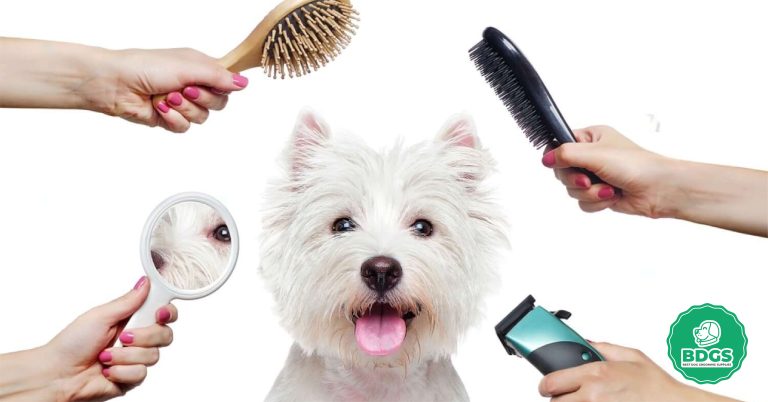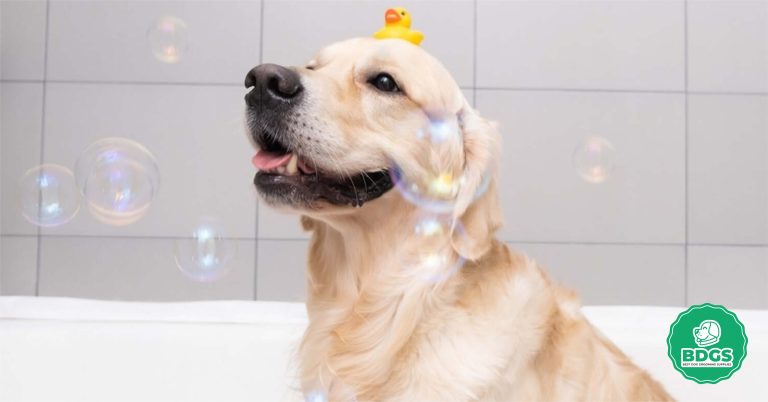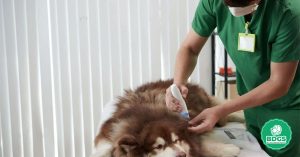Introduction
Dog Grooming Training is an important part of taking care of a pet. It means cleaning, brushing, and caring for your dog’s health and appearance.
Not only does regular cleaning make your dog look cute, but it also keeps their skin and fur healthy. But cleaning can be hard for both you and your dog.
In this article, we’ll talk about handling your dog during cleaning sessions so that it’s a good time for you and your furry friend.
What is Grooming?
Grooming means keeping your dog’s coat clean and in good shape. It means brushing dog fur, trimming nails, cleaning their ears, and bathing them. Grooming your dog makes it look clean and tidy and keeps it from getting mats, tangles, and skin problems.
Why is dog grooming training important for your dog?
Dog grooming training is important for your dog’s overall health. It helps in the ways below:
- Healthy Skin and Coat: Regular brushing removes dirt and other debris from your dog’s coat, making it look healthy and shiny. It also makes skin diseases less likely to happen.
- Bonding Time: Grooming your pet friend is a great way to spend time together. Cleaning can strengthen your friendship and build trust if you do it right.
- Early Health Issues Detection: When you clean your pet, you can look for strange lumps, skin irritations, or other symptoms of illness that a veterinarian might need to examine.
Common Problems During Dog Grooming Training:
Dog grooming training can be challenging at times for several reasons. Let’s take a look at some of the most usual problems:
- Fear or Anxiety: Grooming can make dogs scared or nervous, especially if they’ve had a bad experience or aren’t used to it.
- Pain or discomfort: Grooming can be painful for your dog if they have a sore spot or an injury, making them fight.
- Past Negative Experiences: If your dog has had a wrong time getting groomed, they may associate it with fear and try to avoid it.
Background or Overview of Dog Grooming Training:
Knowing how to handle your dog during cleaning lessons is important so that you both have a good time. Let’s look at some essential ways to handle your dog while cleaning it:
Building Trust and a Positive Association:
Before you start cleaning your dog, building trust and getting your dog excited about the process are important.
- Start Slowly: Grooming should be taught in small, easy steps. Start with short brushing sessions and slowly lengthen them as your dog gets used to them.
- Use treats and praise: While you groom your dog, give it tasty treats and praise it. Positive feedback will help them connect caring with getting treats.
- Have patience and stay calm: Dogs can tell how you feel. Stay calm and patient while you brush your dog; they will feel more at ease.
Types of Restraint Equipment:
Using the right tools to hold the animal down during cleaning sessions can be helpful, but it’s important to do this in a kind and respectful way. Here are some common ways to hold someone back:
- Dog Grooming Table: A grooming table gives you a safe, raised place to clean your dog. It makes it easier to reach your dog from all sides.
- Dog Grooming Loop or Harness: You can use a grooming loop or harness to keep your dog from moving around on the grooming table.
Causes or Factors for Dog Grooming Training:
Understanding why your dog doesn’t want to be groomed can help you deal with the problem more effectively. Here are a few reasons why:
- Fear or Anxiety: Dogs may be afraid of cleaning because the tools make loud noises or because they have had bad experiences.
- Pain or discomfort: If your dog is in pain or discomfort, they may not want to be groomed not to make the situation worse.
- Negative Experiences in the Past: Dogs with bad grooming experiences may develop fear and nervousness around brushing sessions.
Symptoms of Indicators for Dog Grooming Training:
Knowing how to tell if your dog is unhappy or nervous while being groomed is important. Keep an eye out for the following signs:
- Whining or Barking: If your dog whines or barks during cleaning, it may be because they are upset or scared.
- Biting or lunging: If your dog tries to bite or lunge at you during cleaning, it might be because they are uncomfortable or scared.
- Struggling or Resisting: If your dog tries to get away or fights against being groomed, it could be a sign that they are uncomfortable.
Treatment or Solutions for Dog Grooming Training:
Now that we’ve talked about everyday problems and how they show up, let’s look at some effective treatments and answers that will make cleaning easy for you and your pet:
Positive Reinforcement Training:
Positive feedback is a solid way to get animals to behave well when they are being groomed. Use it like this:
- Give treats and praise: When your dog behaves well while being groomed, give them treats and praise to encourage them to keep doing well.
- Use clicker training. It is a great way to mark and praise good behavior while cleaning.
Desensitization and Counter conditioning:
Desensitization is a way to make your dog less scared or anxious about cleaning tools and equipment by letting them get used to them slowly. For counter conditioning to work, you must pair cleaning lessons with good things. Here’s what you need to do:
- Start slowly: Give your dog cleaning tools one at a time so they can get used to them before you use them.
- Reward with treats and praise: When you bring out a grooming tool, give treats and praise to make a good link.
Using Restraint Equipment Appropriately:
If you need to use control tools while cleaning, make sure it is used gently and safely:
- Don’t Use Too Much Force: Never force your dog into a position or hold them too tightly. It can make people feel more afraid and resistant.
- Gradual Introduction: If your dog isn’t used to control equipment, introduce it slowly and give it time to get used to it.
Prevention or Precautions for Dog Grooming:
It’s always better to avoid problems with cleaning than to try to fix them later. Here are some precautions to think about:
- Start Grooming Early in Life: When your dog is young, teach it to be clean. Puppies are more flexible and can get used to being groomed daily.
- Make Grooming a Positive Experience: Make sure that cleaning sessions are good by giving treats, praising, and treating the pet gently.
- Be patient and gentle. Be patient when you’re brushing your dog. Use a calming voice and gentle touch to make it feel comfortable.
Tips for Dog Grooming Training:
Here are some more tips to help you take care of your dog while you clean it:
What to Do for Dog Grooming Training:
- Talk to Your Dog: Use a calm, soothing voice when talking to your dog during brushing to keep them calm.
- Offer Treats or Praise: Reward your dog’s good behavior with treats or praise to make cleaning fun for him.
- Break Sessions into Short Intervals: Grooming sessions that are short and done are better than long ones that are too much.
What Not to Do for Dog Grooming Training:
- Force Your Dog: Don’t force your dog to stay still while you clean it. It can make people feel more stressed and anxious.
- Yell or Punish: Don’t yell at or punish your dog if it tries to get away from you while you’re cleaning it. It will make the dog even more scared.
- Use Harsh Restraint Methods: Don’t use harsh ways to hold your dog back that could hurt or scare it.
Conclusion:
Grooming your dog is an important part of keeping him healthy and happy. Using the tips in this article, you can ensure that cleaning your pet friend is fun and doesn’t stress them out. Be patient, use positive feedback, and try to improve your dog’s cleaning experience. With some work and love, you can build a strong relationship with your dog and help it look and feel its best.
Remember that regular cleaning is good not only for your dog’s looks but also for their general health. So, go ahead and get your dog’s cleaning tools and treat it like a spoiled pooch! Happy cleaning up!
Frequently Asked Questions
It would help if you had patience, understanding, and gentle methods to clean a dog that is hard to handle. Here are some ways to deal with a hard-to-handle dog:
Assess the Situation: Watch the dog’s actions and body language to determine why they are having trouble. Find out what might be making you scared or uncomfortable.
Use positive reinforcement: Reward good behavior with treats, praise, or their favorite toys during cleaning. This positive feedback makes it more likely that the dog will think of brushing as a good thing.
Take Breaks: Take short breaks if the dog gets too tired or stressed during the cleaning process. Let them calm down and get their bearings before going on.
Use Gentle control: Use brushing loops or leashes for gentle control to make sure the dog stays still and is safe during the process.
Avoid Harsh Methods: You should never use rough treatment or penalties. It can make the dog even more scared and make it harder to clean the dog in the future.
Groomers use a variety of tools and methods to keep dogs still while they are being groomed. Some common ways to do things are:
Grooming Tables: Groomers use raised grooming tables that give them more control and make it easier to brush the dog from all sides.
Restraint Equipment: Grooming clips, collars, and bands gently hold the dog in place and stop it from moving suddenly.
Distractions: Groomers often use toys, treats, or soothing words to take the dog’s mind off the cleaning process and make them feel better. It helps the dog stay still and pay attention.
Positive Reinforcement: Groomers use positive reinforcement by treating the dog when it stays still. It helps the dog behave well while being groomed.
Use these ways to calm a dog down so it can be groomed:
Familiar Environment: Groom the dog in a familiar, quiet place where it feels safe and at ease.
Pre-Grooming Relaxation: Play with the dog or take it for a short walk to help the dog calm down before brushing.
Calm and Soothing Voice: Talk to the dog calmly and reassuringly while you clean it to keep it quiet.
Positive Association: By giving treats, praise, and awards during the brushing process, you can help your pet associate cleaning with good things.
Positive Association: Give your dog time to sniff and get used to cleaning tools and equipment before you use them.
Groomers are taught how to treat nervous dogs carefully and with care. Here’s what they do with scared dogs:
Patience: Groomers are kind and patient, so nervous dogs can get used to the cleaning setting at their own pace.
Techniques for easing: Groomers use soft music, scents, and calming sprays to relax the environment.
Short Sessions: Groomers may break the brushing process into shorter, more doable parts for very nervous dogs.
Positive Reinforcement: Groomers use positive reinforcement to reward calm behavior and support relaxation while brushing.
Communication: Groomers watch the dog’s body language and listen to how it sounds to figure out how stressed it is and change their approach accordingly.
By using these methods and paying attention to the dog’s needs, groomers can help nervous dogs feel more comfortable and calm during cleaning.








